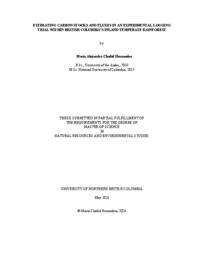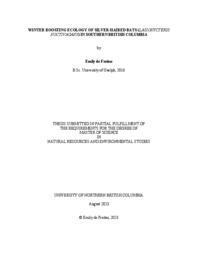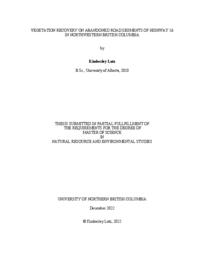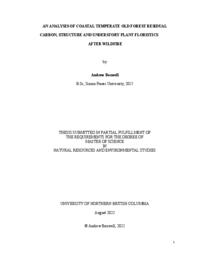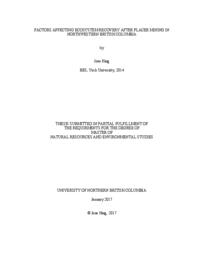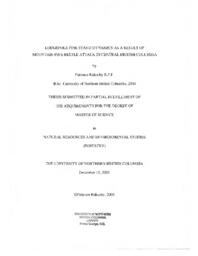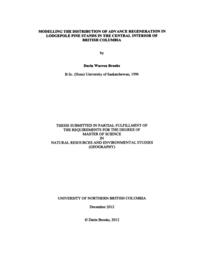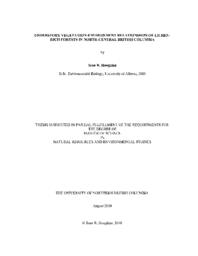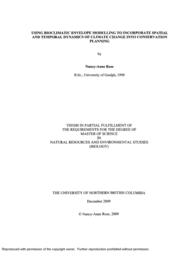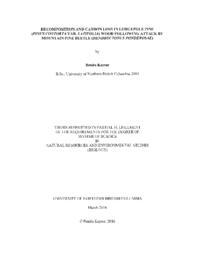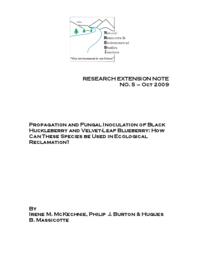Burton, Philip J.
Person Preferred Name
Philip J. Burton
Related Works
Content type
Digital Document
Origin Information
Content type
Digital Document
Origin Information
Content type
Digital Document
Description / Synopsis
The aim of this dissertation is to investigate and quantify biophysical diversity on landslides in the boreal forest of the Peace River Region of northern British Columbia (BC), sampling three landslides that occurred in the last 50 years. Landslides are increasing in the boreal forest, likely driven by climate changes such as increased precipitation and permafrost thaw, and as a derivative of large wildfires. An understanding of ecosystem recovery on landslides is important for conservation and management purposes. Several studies have been done in southern parts of the world to elucidate processes of landslide recovery. However, few studies have addressed landslide recovery in northern climates, and little is known about the biophysical diversity of landslides in this region. This research investigates whether landslides are more biophysically diverse than the surrounding relatively undisturbed terrain, and whether microsite variables or geomorphic diversity are predictors of plant community diversity. Using a series of field sampling campaigns and GIS (geographic information system) mapping exercises, I show that landslides are more biophysically diverse than the surrounding terrain in some respects, while the surrounding undisturbed terrain is more diverse in other aspects. The age and size of landslides also appear to influence diversity. Microsite diversity does not necessarily predict plant diversity. The research highlights the role of invasive plant species in slope stabilisation and plant community makeup. I also show that landslide ponds are disproportionately concentrated on rotational landslides, and that most ponds on landslides occur in the body and toe. I note post-slide modifications such as drainage of landslide ponds and lowering of landslide ridges, but many geomorphic features are expected to endure for decades to millennia. Overall, the research shows that vegetation recovery is complex and may take decades to fully manifest. This study contributes knowledge about plant community and site diversity on landslides by providing quantitative data and comparing those traits with those found on surrounding terrain. These findings can be used as guidance when identifying conservation and management practices for ecological restoration of disturbed slopes.
Origin Information
Content type
Digital Document
Description / Synopsis
Industrial land-use has had profound impacts on Indigenous peoples’ homelands throughout Canada. Over the last century, logging practices in British Columbia have severed peoples’ connections to the land-base, creating access challenges and disrupting the availability of important plant resources. Devil’s club (Oplopanax horridus) is an important medicinal plant to communities in northwestern British Columbia, and there are mounting concerns about the impacts of logging on this ethnobotanically salient species. Over the last 70 years, swathes of productive forests throughout Gitxsan homelands have been impacted by the logging industry. Wilp (house) Luutkudziiwus has seen ~12% of their territory of Madii Lii altered by industrial-scale clearcut logging, which has left a mosaic of even-aged cutblocks that have potentially altered devil’s club habitat. To investigate and detail the potential impacts of logging on devil’s club in Madii Lii territory, this research measured devil’s club health and vigour across a chrono-sequence of clearcut-logged sites compared with traditionally managed and unlogged sites in the territory. In addition, Species Distribution Models in conjunction with two different climate change scenarios (SSP245 moderate GHGs and SSP585 high GHGs) were used to predict habitat suitability for devil’s club in Madii Lii and throughout British Columbia to the end of the 21st century. Results suggest that, compared to traditionally managed areas (and controls), extensive logging in the territory negatively impacted the health and vigour of devil’s club, especially the most desirable individuals (with the largest and thickest stems). In addition, the predictive modelling for both climate scenarios suggest that climate change will increasingly impact highquality devil’s club habitat.
Origin Information
Content type
Digital Document
Description / Synopsis
Many animals spend a considerable amount of time within a shelter, and shelter availability can influence the distribution, abundance, and diversity of animal populations. Shelters used during winter, when ambient temperatures are low (< 0°C), must provide animals with adequate protection to survive through months of adverse conditions. For bats, shelters (roosts) used during winter must also provide microclimates that support energetic requirements for hibernation. Silver-haired bats (Lasionycteris noctivagans) are a tree-roosting species that are migratory throughout much of their range. In parts of northwestern North America, however, they may hibernate locally. Hibernation sites (hibernacula) in regions where winter temperatures are below freezing are typically caves, underground mines, or rock crevice features, as these protect bats from cold temperatures and provide a humid environment that prevents dehydration. In a forested area near Beasley in southern British Columbia, silver-haired bats use an abandoned mine, rock crevices, and trees as roosts during winter. The use of trees as roosts during winter in cold regions (average temperatures < 0°C) is poorly understood. I sought to investigate the winter ecology of tree-roosting silver-haired bats in southern British Columbia. In Chapter 2, I described the characteristics of trees used as hibernacula by silver-haired bats. I hypothesize that bats select winter roost trees non-randomly, and differently across seasons. In Chapter 3, I investigated microclimates and torpor patterns inside silver-haired bat mine, tree, and rock crevice hibernacula. I hypothesize that microclimates vary among winter roost types, and because of these differences, torpor, arousal and movement patterns will differ among tree, rock crevice and mine winter roosts. A majority (66.7%, n = 22) of silver-haired bats used trees as winter roosts during the study. Winter tree roosts were selected non-randomly, and compared to summer roosts, bats used features that provided insulation, such as, cavities in large-diameter, low-decay trees in areas of low canopy closure. Winter trees roosts were colder but more humid compared to the mine and rock crevice roosts. Bats switched among roosts throughout winter depending on ambient conditions but did not alter torpor patterns among roost types. Bats typically used humid roosts (trees) on drier days, and less humid roosts (mine) on more humid days. Further, bats used the well-insulated mine on colder days, and poorly insulated trees and rock crevice roosts on warmer days. Despite this, bats showed more tolerance for colder roost temperatures than expected, remaining in trees during periods of cold (-9°C) temperatures. I conclude that there may be a trade-off between roost humidity and temperature, with bats using multiple hibernacula to optimize energetic benefits in the context of ambient conditions. Trees are an important part of silver-haired bat winter ecology. The use of trees as hibernacula needs to be better understood to inform forest management decisions that better support silver-haired bat conservation by protecting important winter roosts
Origin Information
Content type
Digital Document
Description / Synopsis
Wildfires are a growing threat due to climate change, and they often leave unburned forest patches called fire refugia. While young forests in some regions burn more severely, preliminary observations in central British Columbia suggest that managed juvenile forests exhibit lower fire severity, potentially influenced by fuel moisture conditions, and stand characteristics. To identify the role of fuel moisture in the formation of juvenile stand fire refugia, this research collects and examines groundbased, empirically modelled, and remote sensing indices of greenness, moisture, and fire severity. This thesis investigates the fuel moisture contents (FMC) of duff, fine woody debris, and foliage at six locations near Prince George and Smithers, British Columbia (BC), over two summers (2021 and 2022). A total of 6116 individual samples of foliage, fine woody debris, and duff were collected from open, juvenile, and mature conifer forest stands and analysed for moisture content (MC). On average, the MC of duff and fine woody debris samples was higher in juvenile and mature forests than open sites. In contrast, open forests had higher foliage MC than the other forests. Observations of FMC were used to evaluate the accuracy of FMC estimates extracted from the Canadian Forest Fire Weather Index (FWI) system. Observations of FMC were also compared with remote sensing indices to assess the utility of using spaceborne (Landsat 8&9, Sentinel 2) remote sensing to predict local FMC. Three versions of the FWI model were used to estimate FMC: the original FWI model which uses the closest fire weather station, and versions that used updated parameters based on local fuel conditions and in-stand weather data. When estimating fine woody debris MC, the best statistical results are obtained with locally calibrated models at open stands. However, the original FWI model provides better estimates of duff MC in juvenile stands. For remote sensing of foliar MC in juvenile stands, the Normalized Difference Moisture Index (NDMI) had a higher R2 value (0.334) and a lower RMSE than other indices, while the NDMI gave the best result for foliar MC in mature forests (R2 = 0.160). For fine woody debris and duff MC in open stands, none of the remote sensing indices tested have R2 > 0.1 when estimating duff and fine woody debris MC. However, the RMSE of using empirical models from FWI to estimate duff (lowest at 59.95% RMSE) and fine woody debris (21.13%) MC was higher than remote sensing (41.64% for duff, 17.50% for fine woody debris). Remote sensing indices such as NDMI and GNDVI (Green Normalized Difference Vegetation Index) were used to estimate pre-burn FMC, and the estimated FMC results were found to be generally higher at juvenile stands than mature forest from a case study area from Plateau Complex Wildfire of 2017. Lower remote sensing estimates of FMC in mature stands corresponded to higher burn severities.
Origin Information
Content type
Digital Document
Description / Synopsis
Vegetation recovery on abandoned road segments of Highway 16 in northwestern British Columbia were examined across a climate gradient. The time since road abandonment ranged from 16 to 57 years on sites sampled. Plant cover on asphalt roads was compared with that found on gravel road shoulders using paired t-tests. Plant cover by growth form was further evaluated in response to climate and other environmental predictor variables using multiple regression ‘best fit’ models. Plant community ordination analysis using nonmetric multidimensional scaling was conducted to describe patterns across study sites in species space along environmental gradients. Key drivers of current plant community composition include time since road abandonment, road substrate type, and several different annual climate variables. The best predictor of vascular plant cover and total plant cover was time since road abandonment, but plant community composition was strongly driven by the coastto-interior climate gradient. Non-vascular cover was more abundant on asphalt roads compared to gravel substrates. Woody plant cover was greatest on gravel shoulders compared to gravel or asphalt road centers. Exotic plant cover was negatively correlated with mean annual relative humidity. Plant diversity and species richness were not driven by the climate gradient but instead reflected more site-specific environmental variables. Primary succession on abandoned roads in this study area may be constrained by continued anthropogenic disturbance post-abandonment.
Origin Information
Content type
Digital Document
Description / Synopsis
I assessed some coastal temperature old-growth forests of southwestern British Columbia to understand their post-wildfire structure, carbon storage and biodiversity values. I used a remotely sensed relativized burn ratio and a composite burn index to compare measures of aboveground carbon, structural complexity and floristic diversity between burned and unburned reference plots years after four large wildfires. The unburned reference plots represented the natural range of variation of old growth values. In burned plots, 21 of 60 retained carbon values and 10 plots retained structural values similar to unburned old growth plots. There was an average of 12% floristic similarity between burned and unburned understory plant communities. For land managers, this method offers a way to compare old-growth values after wildfire in order to prioritize protection, salvage, and restoration options.
Origin Information
Content type
Digital Document
Description / Synopsis
Plant communities and soils of grasslands on an elevation gradient and the forest-grassland mosaic in the Cariboo-Chilcotin of British Columbia were examined. Vegetation change along an elevation-climate gradient was analysed, including plant cover, litter cover, species composition, and species richness. Grassland plant communities were compared with associated climate variables and biogeoclimatic classifications. Based on results, an updated classification of grassland ecosystems is proposed with suggestions for management and research. Plant community and soil moisture characteristics of adjacent forests and grasslands were compared. Ten-year-old slash and burn treatments of young forests, and areas of forest encroachment on grasslands were studied to detect potential change between forest and grassland states. Results did not suggest change in ecosystem state between grasslands and forests, with persistent ecosystem legacies a potential source of long-term resilience. Land-use legacies manifested as encroachment of forests on areas of historical grasslands and high cover values of exotic species.
Origin Information
Content type
Digital Document
Origin Information
Content type
Digital Document
Origin Information
Content type
Digital Document
Origin Information
Content type
Digital Document
Origin Information
Content type
Digital Document
Origin Information
Content type
Digital Document
Origin Information
Content type
Digital Document
Origin Information
Content type
Digital Document
Origin Information
Content type
Digital Document
Origin Information
Content type
Digital Document
Description / Synopsis
"There is a great demand for the inclusion of berry-producing plants, such as wild blueberries or huckleberries (Vaccinium species), in forest restoration and post-industrial reclamation efforts, due to their value to wildlife and traditional users of the land. However, the biology and propagation requirements of northern Vaccinium species and their potential for use in reclamation, ecological restoration, and horticulture are largely unexplored. Propagation trials of black huckleberry (V. membranaceum) and velvet-leaf blueberry (V. myrtilloides) using seeds, hardwood cuttings, and rhizome cuttings were carried out to determine propagation protocols. Outdoor trials tested the influences of mycorrhizal inoculation and soil amendment on seedling survival. Seeds and rhizome cuttings were found to be the most effective propagation techniques for Vaccinium. Soil amendment increased outdoor seedling survival; however, none of the seedlings showed mycorrhizal colonization, regardless of inoculation treatment. These Vaccinium species are dominant components of climax sub-boreal forests, well adapted to recovery after fire; however it is difficult for them to establish rapidly on degraded soils, making soil amendments important to their use in ecological restoration. Growers must have patience when growing northern Vaccinium plants, but successful establishment is possible with adequate care and planning."
Origin Information

